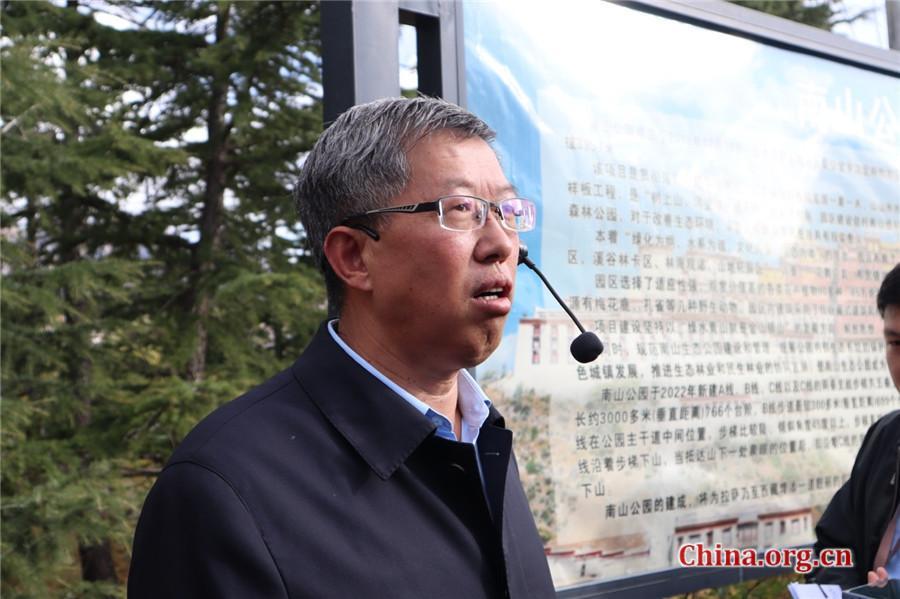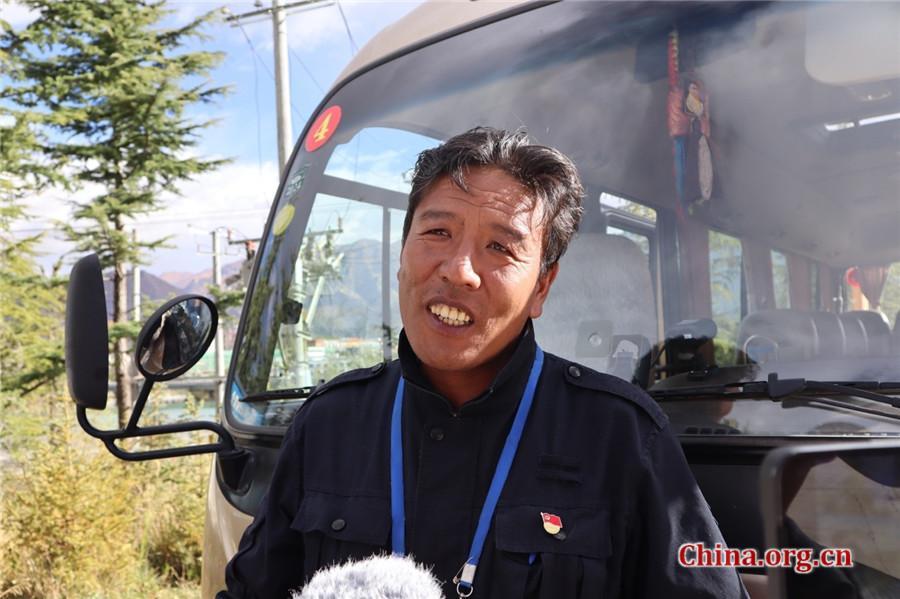Lhasa transforms barren mountains into green area
- By Qin Qi
 0 Comment(s)
0 Comment(s) Print
Print E-mail China.org.cn, October 13, 2023
E-mail China.org.cn, October 13, 2023
Lhasa, the capital city of southwestern China's Tibet autonomous region, has explored new ways to add greenery suited to its own unique terrains. South and North Mountains Afforestation Project launched in 2021 stands as a vivid example of the plateau city's efforts to improve the environment in an effective manner.

This photo taken on Oct. 11, 2023, shows the Potala Palace seen from the Nanshan Park in Lhasa, the capital of southwestern China's Tibet autonomous region. (Photo by Qin Qi/China.org.cn)
According to the plan, by 2030, 137,800 hectares of green areas will be added across the South and North Mountains in Lhasa. In 2022, the city added a total of 37,247 hectares of green areas.

On Oct. 11, 2023, Li Baoping, an official of the Lhasa Municipal Forestry and Grassland Administration, introduces the implementation process of the South and North Mountains Afforestation Project at the Nanshan Park in Lhasa, capital of southwest China's Tibet autonomous region. (Photo by Qin Qi/China.org.cn)
Local forestry and grassland authority has made efforts to find effective ways to turn the mountains green. "We have planted varying kinds of trees in accordance with the altitudes," said Li Baoping, an official of the Lhasa Municipal Forestry and Grassland Administration . Li explained that trees were widely planted in the areas below 3,900 meters, while shrubs were largely seeded in the areas between 3,900 to 4,000 meters.
To better protect the mountains and local ecology during the afforestation process, local authority has adopted multiple ways to plant trees. For the areas with the altitude between 4,000 to 4,100 meters, the city sealed off the mountains to facilitate afforestation; for the areas between 4,100 to 4,200 meters, the city adopted spot-planting method, making sure species are planted with the right techniques in suitable places, Li said.
Li said he was deeply touched by the unity and passion for the afforestation project demonstrated by the people of different ethnic groups. "Due to the rugged mountain roads, we had to carry the seeds and other materials up to the mountain by human," Li said. "People of different ethnic groups, including Han, Tibetan, and Yi, actively involved themselves in the work and made their contributions to the construction of a beautiful Lhasa."
The afforestation project has greatly improved the local environment. It is expected to add about 49.8 million metric tons of water storage, release a total of 193,000 metric tons of oxygen, and generate around 1.49 billion yuan (US$203 million) of ecological value per year.
The project has also greatly boosted local people's sense of gain and happiness. In the first 10 months of this year, the number of people involved in the project reached 380,000, and a total of 1 billion yuan of salaries were paid to them, Li said. "It's fair to say that we have achieved win-win results in protecting ecology and increasing residents' income," he said.

On Oct. 11, 2023, Zhaxiqupei, a Tibetan forest ranger working at Nanshan Park, shares his tree-planting experience with journalists, at the Nanshan Park in Lhasa, the capital of southwest China's Tibet autonomous region. (Photo by Qin Qi/China.org.cn)
Zhaxiqupei, a Tibetan forest ranger who worked at Nanshan Park since 2012, exclaimed over the tremendous changes he saw in the mountain. He said when he first came to the place 10 years ago, it was a barren mountain full of sands and stones, severely lacking the conditions for planting trees. The planting team tirelessly dug pits on the stones, put saplings into the pits, refilled those holes with soil, made bigger puddles, and then watered those saplings on a regular basis, Zhaxiqupei recalled. After the unremitting endeavor made by all the working staff, the saplings finally survived and have grown up into big trees. Now, the seeds of the fruits on the trees falling in the soil are growing to be towering trees. "Our saplings finally have their own children," Zhaxiqupei said with a smile.
Planting trees is not merely a job for many staff working in the mountains, it has been incorporated into their everyday life. Zhaxiqupei was encouraged to see the once-barren mountain turning into green land, and believed afforestation would bring more tangible benefits to his life.
Now, planting trees in the mountain has become a ritual for Zhaxiqupei to celebrate the important moments in his life. "Last year, I planted a total of 43 trees at the altitude of over 4,000 meters to celebrate my 43rd birthday," the veteran park ranger said proudly.






Go to Forum >>0 Comment(s)